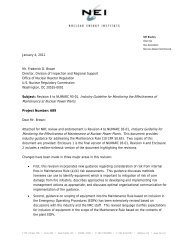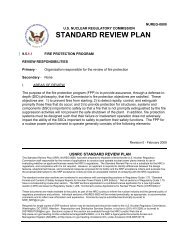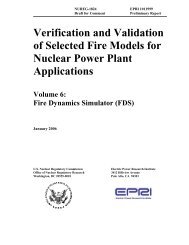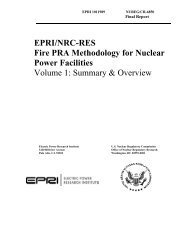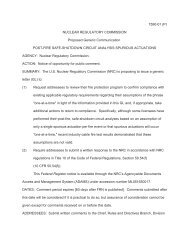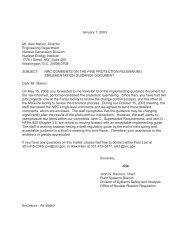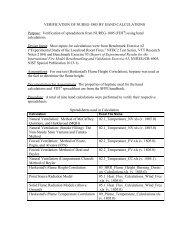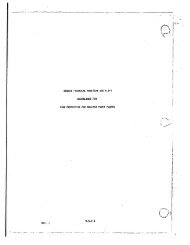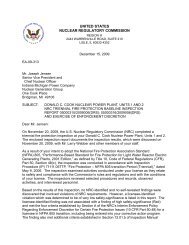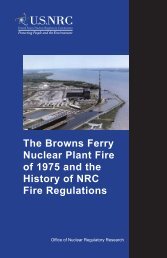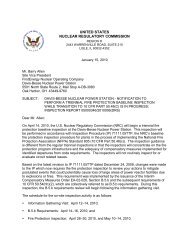Browns Ferry Resident - 06-004 - Public Access Portal
Browns Ferry Resident - 06-004 - Public Access Portal
Browns Ferry Resident - 06-004 - Public Access Portal
You also want an ePaper? Increase the reach of your titles
YUMPU automatically turns print PDFs into web optimized ePapers that Google loves.
October 30, 20<strong>06</strong><br />
Tennessee Valley Authority<br />
ATTN.: Mr. K. W. Singer<br />
Chief Nuclear Officer and<br />
Executive Vice President<br />
6A Lookout Place<br />
1101 Market Street<br />
Chattanooga, TN 37402-2801<br />
SUBJECT:<br />
BROWNS FERRY NUCLEAR PLANT - NRC INTEGRATED INSPECTION<br />
REPORT 05000259/20<strong>06</strong><strong>004</strong>, 05000260/20<strong>06</strong><strong>004</strong>, 05000296/20<strong>06</strong><strong>004</strong>, AND<br />
07200052/20<strong>06</strong>001<br />
Dear Mr. Singer:<br />
On September 30, 20<strong>06</strong>, the United States Nuclear Regulatory Commission (NRC) completed<br />
an inspection at your operating <strong>Browns</strong> <strong>Ferry</strong> Unit 2 and 3 reactor facilities. The enclosed<br />
integrated quarterly inspection report documents the inspection results, which were discussed<br />
on October 5, 20<strong>06</strong>, with Brian O’Grady and other members of your staff.<br />
The inspection examined activities conducted under your licenses as they relate to safety and<br />
compliance with the Commission’s rules and regulations and with the conditions of your<br />
licenses. The inspectors reviewed selected procedures and records, observed activities, and<br />
interviewed personnel.<br />
Additionally, the enclosed report also documents some inspection of Unit 1 that was performed<br />
per our letter to you on December 29, 2<strong>004</strong>, regarding the transition of Unit 1 into the Reactor<br />
Oversight Program (ROP). In that letter we indicated that the NRC had determined that the<br />
ROP cornerstones of Occupational Radiation Safety, <strong>Public</strong> Radiation Safety, Emergency<br />
Preparedness, and Physical Protection would be incorporated into the routine ROP baseline<br />
inspection program effective January 1, 2005. Remaining results from our inspection of your<br />
Unit 1 Recovery Project continue to be documented in a separate Unit 1 integrated inspection<br />
report.<br />
This report documents an NRC-identified finding which was determined to involve a violation of<br />
NRC requirements. However, because this finding was of very low safety significance and was<br />
entered into your corrective action program, the NRC is treating the violation as a non-cited<br />
violation (NCV) consistent with Section VI.A of the NRC Enforcement Policy. In addition, a<br />
licensee-identified violation which was determined to be of very low safety significance is listed<br />
in this report. If you contest any non-cited violation or finding in the enclosed report, you<br />
should provide a response within 30 days of the date of this inspection report, with the basis for<br />
your denial, to the United States Nuclear Regulatory Commission, ATTN: Document Control<br />
Desk, Washington DC 20555-0001; with copies to the Regional Administrator, Region II; the<br />
Director, Office of Enforcement, United States Nuclear Regulatory Commission, Washington,<br />
DC 20555-0001; and the NRC Senior <strong>Resident</strong> Inspector at the <strong>Browns</strong> <strong>Ferry</strong> Nuclear Plant.
TVA 2<br />
In accordance with 10 CFR 2.390 of the NRC’s “Rules of Practice,” a copy of this letter, its<br />
enclosure and your response, if any, will be available electronically for public inspection in the<br />
NRC <strong>Public</strong> Document Room or from the <strong>Public</strong>ly Available Records (PARS) component of<br />
NRC’s document system (ADAMS). ADAMS is accessible from the NRC Web site at<br />
http://www.nrc.gov/reading-rm/adams.html (the <strong>Public</strong> Electronic Reading Room).<br />
Sincerely,<br />
/RA/<br />
Malcolm T. Widmann, Chief<br />
Reactor Projects Branch 6<br />
Division of Reactor Projects<br />
Docket Nos.: 50-259, 50-260, 50-296, 72-052<br />
License Nos.: DPR-33, DPR-52, DPR-68<br />
Enclosure: Inspection Report 05000259/20<strong>06</strong><strong>004</strong>, 05000260/20<strong>06</strong><strong>004</strong>, 05000296/20<strong>06</strong><strong>004</strong>,<br />
and 07200052/20<strong>06</strong>001 w/Attachment: Supplemental Information<br />
cc w/encl.: (See page 3)
TVA 2<br />
In accordance with 10 CFR 2.390 of the NRC’s “Rules of Practice,” a copy of this letter, its<br />
enclosure and your response, if any, will be available electronically for public inspection in the<br />
NRC <strong>Public</strong> Document Room or from the <strong>Public</strong>ly Available Records (PARS) component of<br />
NRC’s document system (ADAMS). ADAMS is accessible from the NRC Web site at<br />
http://www.nrc.gov/reading-rm/adams.html (the <strong>Public</strong> Electronic Reading Room).<br />
Sincerely,<br />
/RA/<br />
Malcolm T. Widmann, Chief<br />
Reactor Projects Branch 6<br />
Division of Reactor Projects<br />
Docket Nos.: 50-259, 50-260, 50-296, 72-052<br />
License Nos.: DPR-33, DPR-52, DPR-68<br />
Enclosure: Inspection Report 05000259/20<strong>06</strong><strong>004</strong>, 05000260/20<strong>06</strong><strong>004</strong>, 05000296/20<strong>06</strong><strong>004</strong>,<br />
and 07200052/20<strong>06</strong>001 w/Attachment: Supplemental Information<br />
G PUBLICLY AVAILABLE G NON-PUBLICLY AVAILABLE G SENSITIVE G NON-SENSITIVE<br />
ADAMS: G Yes ACCESSION NUMBER:_________________________<br />
OFFICE RII:DRP RII:DRP RII:DRP RII:DRP RII:DRS RII:DRS<br />
SIGNATURE LXG1 TMR RLM MSF JHM2 for JHM2 for<br />
NAME LGarner:aws TRoss RMonk SFreeman GLaska SRose<br />
DATE 10/27/20<strong>06</strong> 10/30/20<strong>06</strong> 10/30/20<strong>06</strong> 10/30/20<strong>06</strong> 10/27/20<strong>06</strong> 10/27/20<strong>06</strong><br />
E-MAIL COPY YES NO YES NO YES NO YES NO YES NO YES NO YES NO<br />
OFFICIAL RECORD COPY DOCUMENT NAME: C:\FileNet\ML<strong>06</strong>3040002.wpd
TVA 3<br />
cc w/encl.:<br />
Ashok S. Bhatnagar<br />
Senior Vice President<br />
Nuclear Operations<br />
Tennessee Valley Authority<br />
Electronic Mail Distribution<br />
Larry S. Bryant, General Manager<br />
Nuclear Engineering<br />
Tennessee Valley Authority<br />
Electronic Mail Distribution<br />
Brian O’Grady, Site Vice President<br />
<strong>Browns</strong> <strong>Ferry</strong> Nuclear Plant<br />
Tennessee Valley Authority<br />
Electronic Mail Distribution<br />
Robert J. Beecken, Vice President<br />
Nuclear Operations<br />
Tennessee Valley Authority<br />
Electronic Mail Distribution<br />
General Counsel<br />
Tennessee Valley Authority<br />
Electronic Mail Distribution<br />
John C. Fornicola, Manager<br />
Nuclear Assurance and Licensing<br />
Tennessee Valley Authority<br />
Electronic Mail Distribution<br />
State Health Officer<br />
Alabama Dept. of <strong>Public</strong> Health<br />
RSA Tower - Administration<br />
Suite 1552<br />
P. O. Box 303017<br />
Montgomery, AL 36130-3017<br />
Chairman<br />
Limestone County Commission<br />
310 West Washington Street<br />
Athens, AL 35611<br />
Masoud Bajestani, Vice President<br />
<strong>Browns</strong> <strong>Ferry</strong> Unit 1 Restart<br />
<strong>Browns</strong> <strong>Ferry</strong> Nuclear Plant<br />
Tennessee Valley Authority<br />
P. O. Box 2000<br />
Decatur, AL 35609<br />
Robert G. Jones, General Manager<br />
Site Operations<br />
<strong>Browns</strong> <strong>Ferry</strong> Nuclear Plant<br />
Tennessee Valley Authority<br />
P. O. Box 2000<br />
Decatur, AL 35609<br />
Distribution w/encl: (See page 4)<br />
Bruce M. Aukland, Plant Manager<br />
<strong>Browns</strong> <strong>Ferry</strong> Nuclear Plant<br />
Tennessee Valley Authority<br />
Electronic Mail Distribution<br />
Glenn W. Morris, Manager<br />
Corporate Nuclear Licensing<br />
and Industry Affairs<br />
Tennessee Valley Authority<br />
Electronic Mail Distribution<br />
William D. Crouch, Manager<br />
Licensing and Industry Affairs<br />
<strong>Browns</strong> <strong>Ferry</strong> Nuclear Plant<br />
Tennessee Valley Authority<br />
Electronic Mail Distribution
TVA 4<br />
Report to Karl W. Singer from Malcolm T. Widmann dated October 30 , 20<strong>06</strong>.<br />
SUBJECT: BROWNS FERRY NUCLEAR PLANT - INTEGRATED INSPECTION REPORT<br />
05000259/20<strong>06</strong><strong>004</strong>, 05000260/20<strong>06</strong><strong>004</strong>, 05000296/20<strong>06</strong><strong>004</strong>, and 07200052/20<strong>06</strong>001<br />
Distribution w/encl.:<br />
M. Chernoff, NRR<br />
L. Slack, RII EICS<br />
RIDSNRRDIRS<br />
PUBLIC
U.S. NUCLEAR REGULATORY COMMISSION<br />
REGION II<br />
Docket Nos.: 50-259, 50-260, 50-296<br />
License Nos.:<br />
DPR-33, DPR-52, DPR-68<br />
Report Nos.: 05000259/20<strong>06</strong><strong>004</strong>, 05000260/20<strong>06</strong><strong>004</strong>,<br />
05000296/20<strong>06</strong><strong>004</strong>, and 07200052/20<strong>06</strong>001<br />
Licensee:<br />
Tennessee Valley Authority (TVA)<br />
Facility: <strong>Browns</strong> <strong>Ferry</strong> Nuclear Plant, Units 1, 2, and 3<br />
Location:<br />
Corner of Shaw and Nuclear Plant Roads<br />
Athens, AL 35611<br />
Dates: July 1 - September 30, 20<strong>06</strong><br />
Inspectors:<br />
T. Ross, Senior <strong>Resident</strong> Inspector<br />
R. Monk, <strong>Resident</strong> Inspector<br />
S. Freeman, Senior <strong>Resident</strong> Inspector (Section 1R07)<br />
G. Laska, Senior Operations Examiner (Section 1R11.2)<br />
S. Rose, Senior Operations Examiner (Section 1R11.2)<br />
Approved by:<br />
Malcolm T. Widmann, Chief<br />
Reactor Project Branch 6<br />
Division of Reactor Projects<br />
Enclosure
SUMMARY OF FINDINGS<br />
IR 05000259/20<strong>06</strong><strong>004</strong>, 05000260/20<strong>06</strong><strong>004</strong>, 05000296/20<strong>06</strong><strong>004</strong>, 07200052/20<strong>06</strong>001;<br />
07/01/20<strong>06</strong> - 09/30/20<strong>06</strong>; <strong>Browns</strong> <strong>Ferry</strong> Nuclear Plant, Units 1, 2, and 3; Maintenance<br />
Effectiveness, and Identification & Resolution of Problems<br />
The report covered a three-month period of routine inspections by the resident inspectors, a<br />
senior resident inspector from another site, and two senior operations examiners from Region<br />
II. One Severity Level IV non-cited violation was identified. The significance of most findings<br />
are indicated by their color (Green, White, Yellow, Red) using Inspection Manual Chapter <strong>06</strong>09,<br />
“Significance Determination Process” (SDP). Findings for which the SDP does not apply may<br />
be Green or assigned a severity level after NRC management review. The NRC’s program for<br />
overseeing the safe operation of commercial nuclear power reactors is described in NUREG-<br />
1649, Reactor Oversight Process, Revision 3, dated July 2000.<br />
A. NRC-Identified and Self-Revealing Findings<br />
• A Severity Level IV, non-cited violation (NCV) of 10 CFR 50.73(a)(2)(i)(B) was<br />
identified by the inspectors for the licensee’s failure to submit the required<br />
licensee event reports for several instances of multiple main steam relief valve<br />
(MSRV) test failures that resulted in a condition prohibited by Technical<br />
Specifications. This issue was documented in the licensee’s corrective action<br />
program as Problem Evaluation Report 112190.<br />
The licensee’s failure to provide written event reports was considered greater<br />
than minor because it could potentially impact the NRC's ability to carry out its<br />
regulatory function. However, since this failure to report per 10 CFR 50.73 did<br />
not actually impede or influence regulatory action, and the condition that required<br />
reporting under 10 CFR 50.73 was determined to be of very low safety<br />
significance because the as-found MSRV lift pressures were bounded by<br />
accident analyses, the NRC has characterized the significance of this reporting<br />
violation as a Severity Level IV in accordance with Section IV.A.3 and<br />
Supplement I of the NRC Enforcement Policy (Section 1R12)<br />
B. Licensee-Identified Violations<br />
A violation of very low safety significance, which was identified by the licensee, has been<br />
reviewed by the inspectors. Corrective actions taken or planned by the licensee have<br />
been entered into the licensee’s corrective action program. The violation and corrective<br />
actions are listed in Section 4OA7 of this report.<br />
Enclosure
REPORT DETAILS<br />
Summary of Plant Status<br />
Unit 1 was defueled and in a recovery status for the entire report period.<br />
Unit 2 operated at essentially full power for the entire report period, except for two unplanned<br />
downpowers. On July 4, operators reduced power to 82% to remove the 2B reactor feedwater<br />
pump (RFP) from service in order to repair a through wall leak on the 2B RFP minimum flow<br />
valve body. The repairs were completed and the unit was returned to full power the same day.<br />
On September 20, operators conducted a rapid down power of Unit 2 to 91% power due to loss<br />
of level control of the 2A1 main feedwater (MFW) heater. Repairs were made and the unit was<br />
returned to full power the same day.<br />
Unit 3 operated at essentially full power for the entire report period, except for two manual<br />
reactor scrams, a runback, and a rapid down power. On July 22, operators reduced power to<br />
85% due to unexpected isolation of the 3A3 MFW heater from a spurious high level indication.<br />
The 3A3 MFW heater was returned to service the same day. On August 16, an unexpected<br />
runback of the 3A recirculation pump to 96% power occurred due to an automatic bypass of the<br />
variable frequency drive (VFD) A4 power cell following an electrical fault. Full power was<br />
restored later that day with the A4 cell still bypassed. On August 19, Unit 3 was manually<br />
scrammed from 100% power due to the sudden, simultaneous loss of both VFD’s caused by an<br />
ethernet data storm that locked up the VFD central processing units (CPU). The VFD’s were<br />
restored and the unit was returned to full power on August 22. On August 29, Unit 3 was<br />
manually scrammed from 100% power due to a large, unisolable electrohydraulic (EHC) fluid<br />
leak caused by an O-ring failure of the fast acting solenoid valve (FASV) connected to main<br />
turbine Control Valve #2. Repairs were made and the unit was returned to full power on<br />
September 1.<br />
1. REACTOR SAFETY<br />
Cornerstones: Initiating Events, Mitigating Systems, and Barrier Integrity<br />
1R04<br />
Equipment Alignment<br />
.1 Partial Walkdown<br />
a. Inspection Scope<br />
Partial System Walkdown. The inspectors performed partial walkdowns of the safety<br />
systems listed below to verify train operability, as required by the plant Technical<br />
Specifications (TS), while the other redundant trains were out of service or after the<br />
specific safety system was returned to service following maintenance. These<br />
inspections included reviews of applicable TS, operating instructions (OI), and/or piping<br />
and instrumentation drawings (P&IDs), which were compared with observed equipment<br />
configurations to identify any discrepancies that could affect operability of the redundant<br />
train or backup system. The systems selected for walkdown were also chosen due to<br />
their relative risk significance from a Probabilistic Safety Assessment (PSA) perspective<br />
Enclosure
4<br />
for the existing plant equipment configuration. The inspectors verified that selected<br />
breaker, valve position, and support equipment were in the correct position for system<br />
operation.<br />
• 3A Control Rod Drive (CRD) Hydraulic System per PI&D flow diagrams 0-<br />
47E820 and 3-47E820, and 3-OI-85, Control Drive System<br />
• Unit 3 Division II Core Spray (CS) system per PI&D flow diagram 3-47E814 and<br />
3-OI-75, Core Spray System<br />
• Unit 2 High Pressure Coolant Injection (HPCI) system per PI&D flow diagram 2-<br />
47E812 and 2-OI-73, High Pressure Coolant Injection System<br />
• Unit 2 Reactor Core Isolation Cooling (RCIC) system per PI&D flow diagram 2-<br />
47E813 and 2-OI-71, Reactor Core Isolation Cooling System<br />
b. Findings<br />
No findings of significance were identified.<br />
.2 Complete Walkdown<br />
a. Inspection Scope<br />
The inspectors completed a detailed alignment verification of the Unit 3 Standby Liquid<br />
Control (SLC) system, using the applicable P&ID flow diagram 3-47E854-1 and 3-OI-63,<br />
Standby Liquid Control System, to walkdown and verify equipment alignment and<br />
operability. The inspectors reviewed relevant portions of the Updated Final Safety<br />
Analysis Report (UFSAR) and TS. This detailed walkdown also verified electrical power<br />
alignment, the condition of applicable system instrumentation and controls, component<br />
labeling, pipe hangers and support installation, and associated support systems status.<br />
Furthermore, the inspectors examined control room operator logs; the applicable<br />
System Health Report; and any problem evaluation reports (PERs) that could affect<br />
system alignment and operability for the past year.<br />
b. Findings<br />
1R05<br />
Fire Protection<br />
a. Inspection Scope<br />
Walkdowns. The inspectors reviewed licensee procedures, Standard Program and<br />
Process (SPP)-10.10, Control of Transient Combustibles, and SPP-10.9, Control of Fire<br />
Protection Impairments, and conducted a walkdown of the fire areas (FA) and fire zones<br />
(FZ) listed below. Selected fire areas/zones were examined in order to verify licensee<br />
control of transient combustibles and ignition sources; the material condition of fire<br />
protection equipment and fire barriers; and operational lineup and operational condition<br />
of fire protection features or measures. Also, the inspectors verified that selected fire<br />
protection impairments were identified and controlled in accordance with procedure<br />
SPP-10.9. Furthermore, the inspectors reviewed applicable portions of the Site Fire<br />
Enclosure
5<br />
Hazards Analysis, Volumes 1 and 2 and Pre-Fire Plan drawings to verify that the<br />
necessary fire fighting equipment, such as fire extinguishers, hose stations, ladders, and<br />
communications equipment, were in place.<br />
• Unit 2 Reactor Building Elev 621 and North 639 (Fire Zone (FZ) 2-5)<br />
• Unit 2 Reactor Building South Elev 639 (FZ 2-6)<br />
• Unit 3 Reactor Building Elev 621 and North 639 (FZ 3-4)<br />
• 1A Electric Board Room (Fire Area (FA) 5)<br />
• Unit 3 Reactor Building Elev 519 thru 565 East (FZ 3-2)<br />
• Unit 3 Reactor Building Elev 519 thru 565 West (FZ 3-1)<br />
• Unit 2 Reactor Building Elev 593 North (FZ 2-3)<br />
• Unit 2 Reactor Building Elev 593 South and Residual Heat Removal (RHR) Heat<br />
Exchanger Rooms (FZ 2-4)<br />
• 1A 480V Shutdown Board Room (FA 6)<br />
• 1B 480V Shutdown Board Room (FA 7)<br />
b. Findings<br />
1R<strong>06</strong><br />
External Flood Protection Measures<br />
a. Inspection Scope<br />
The inspectors reviewed plant design features and licensee procedures intended to<br />
protect the plant and its safety-related equipment from external flooding events. The<br />
inspectors reviewed flood analysis documents including: UFSAR Section 2.4,<br />
Hydrology, Water Quality, and Marine Biology, which included Appendix 2.4A, Maximum<br />
Possible Flood; and UFSAR Section 12.2.9.2.3 Flood Gate, for licensee commitments.<br />
The inspectors also interviewed cognizant licensee personnel knowledgeable about site<br />
flood protection measures and plant drainage plans. The inspectors performed<br />
walkdowns of risk-significant areas, susceptible systems and equipment, including the<br />
residual heat removal service water (RHRSW) and emergency equipment cooling water<br />
(EECW) pump rooms “A”, “B”, “C” and “D”, including the associated structures. The<br />
inspectors performed walkdowns of the Units 3 emergency diesel generator (EDG)<br />
rooms, and the associated cable/piping wall penetrations in rooms “3A”,”3B”, “3C”, and<br />
“3D”. The inspectors’ review included flood-significant features such as level switches,<br />
room sumps, door seals and the Reactor Building Flood Gate. Plant procedures and<br />
calculations for coping with flooding events were also reviewed to verify that licensee<br />
actions and maintenance practices were consistent with the plant’s design basis<br />
assumptions. The procedures reviewed during this inspection are listed in the<br />
Attachment to this report.<br />
The inspectors also reviewed licensee corrective action documents for flood-related<br />
items identified in PERs written from 2005 through early 20<strong>06</strong> to verify the adequacy of<br />
the corrective actions. The inspectors reviewed selected completed preventive<br />
maintenance procedures and work orders for identified level switches, pumps and flood<br />
barriers (e.g., Flood Gate) for completeness and frequency.<br />
Enclosure
6<br />
b. Findings<br />
No findings of significance were identified.<br />
1R07<br />
Annual Heat Sink Performance<br />
a. Inspection Scope<br />
The inspectors reviewed the licensee's biofouling controls to verify that the licensee had<br />
identified any potential deficiencies that could lead to heat exchanger flow blockage<br />
problems due to biological macro-fouling and to verify that the licensee had identified<br />
any problems that could affect multiple safety related heat exchangers. Specifically, the<br />
inspectors reviewed the licensee's raw water fouling, corrosion control, and chemical<br />
treatment procedures to ensure they had a program, based on industry standards, for<br />
controlling clams and other biological agents. The inspectors also reviewed the data for<br />
several RHR heat exchanger visual inspections and EECW system treatments to gage<br />
the effectiveness of the program. Documents reviewed are in the Attachment to this<br />
report.<br />
b. Findings<br />
No findings of significance were identified.<br />
1R11<br />
Licensed Operator Requalification<br />
.1 Requalification Activities Review<br />
a. Inspection Scope<br />
On August 7, 20<strong>06</strong>, inspectors observed the as-found simulator evaluations for group A<br />
of crew #4 in accordance with OPL177.01, Failure of Reactor Protection System “A”<br />
With Failure of “C” Standby Gas Treatment to Start, Recirc Pump Trip, Reactor Power<br />
Oscillations, Anticipated Transient Without Scram, Stuck Open Safety Relief Valve, and<br />
Safety Relief Valve Tailpipe break In Containment. The scenario was challenging, and<br />
involved critical equipment failures, abnormal operational transients and accident<br />
conditions.<br />
The inspectors specifically evaluated the following attributes related to the operating<br />
crews’ performance:<br />
• Clarity and formality of communication<br />
• Ability to take timely action to safely control the unit<br />
• Prioritization, interpretation, and verification of alarms<br />
• Correct use and implementation of Abnormal Operating Instructions (AOI),<br />
Emergency Operating Instructions (EOI) and Operational Contingencies<br />
• Timely and appropriate Emergency Action Level declarations per Emergency<br />
Plan Implementing Procedures (EPIP)<br />
Enclosure
7<br />
• Control board operation and manipulation, including high-risk operator actions<br />
• Command and Control provided by the Unit Supervisor and Shift Manager<br />
The inspectors also attended the post-exam critique to assess the effectiveness of the<br />
licensee evaluators, and to verify that licensee-identified issues were comparable to<br />
issues identified by the inspector.<br />
b. Findings<br />
No findings of significance were identified.<br />
.2 Biennial Review<br />
a. Inspection Scope<br />
The inspectors reviewed the facility operating history and associated documents in<br />
preparation for this inspection. During the week of September 18, 20<strong>06</strong>, the inspectors<br />
reviewed documentation, interviewed licensee personnel, and observed the<br />
administration of operating tests associated with the licensee’s operator requalification<br />
program. Each of the activities performed by the inspectors was done to assess the<br />
effectiveness of the licensee in implementing requalification requirements identified in<br />
10 CFR Part 55, “Operators’ Licenses.” The evaluations were also performed to<br />
determine if the licensee effectively implemented operator requalification guidelines<br />
established in NUREG-1021, “Operator Licensing Examination Standards for Power<br />
Reactors,” and Inspection Procedure 71111.11, “Licensed Operator Requalification<br />
Program.” The inspectors also evaluated the licensee’s simulation facility for adequacy<br />
for use in operator licensing examinations using ANSI/ANS-3.5-1985, “American<br />
National Standard For Nuclear Power Plant Simulators for use in Operator Training and<br />
Examination.” The inspectors observed two crews during the performance of the<br />
operating tests. Documentation reviewed included written examinations, Job<br />
Performance Measures (JPMs), simulator scenarios, licensee procedures, on-shift<br />
records, simulator modification request records and performance test records, the<br />
feedback process, licensed operator qualification records, re-mediation plans, and<br />
watchstanding and medical records. These records were inspected using the criteria<br />
listed in Inspection Procedure 71111.11. A list of the documents reviewed by the<br />
inspectors is included in the List of Documents Reviewed attachment to this report.<br />
b. Findings<br />
No findings of significance were identified.<br />
Enclosure
8<br />
1R12<br />
Maintenance Effectiveness<br />
Routine Maintenance Effectiveness<br />
a. Inspection Scope<br />
The inspectors reviewed the two systems listed below with regard to some or all of the<br />
following attributes: (1) work practices; (2) identifying and addressing common cause<br />
failures; (3) scoping in accordance with 10 CFR 50.65(b) of the maintenance rule (MR);<br />
(4) characterizing reliability issues for performance; (5) trending key parameters for<br />
condition monitoring; (6) charging unavailability for performance; (7) appropriateness of<br />
performance criteria in accordance with 10 CFR 50.65(a)(2); (8) system classification in<br />
accordance with 10 CFR 50.65(a)(1); and (9) appropriateness and adequacy of (a)(1)<br />
goals and corrective actions (i.e., Ten Point Plan). Both of these systems had exceeded<br />
their reliability performance criteria and were classified as (a)(1). The inspectors also<br />
compared the licensee’s performance against site procedure SPP-6.6, Maintenance<br />
Rule Performance Indicator Monitoring, Trending and Reporting; Technical Instruction<br />
0-TI-346, Maintenance Rule Performance Indicator Monitoring, Trending and Reporting;<br />
and SPP 3.1, Corrective Action Program. The inspectors also reviewed applicable work<br />
orders, surveillance records, PERs, system health reports, engineering evaluations, and<br />
MR expert panel minutes; and attended MR expert panel meetings to verify that<br />
regulatory and procedural requirements were met.<br />
• RHRSW/EECW Motor Failures<br />
• Main Steam Safety/Relief Valve (MSRV) Setpoint Drift and Pilot Valve Leakage<br />
b. Findings<br />
Introduction: A Severity Level IV, non-cited violation (NCV) of 10 CFR 50.73(a)(2)(i)(B)<br />
was identified by the inspectors for the licensee’s failure to submit the required licensee<br />
event reports (LERs) for several instances of multiple MRSV test failures that occurred<br />
following previous Unit 2 and 3 refueling outages. These test failures resulted in<br />
conditions prohibited by TS 3.4.3 due to two or more MSRV as-found lift settings being<br />
found outside ± 3% of the TS lift setpoints.<br />
Description: As-found MSRV lift setpoint testing is required by TS 3.4.3 and the<br />
licensee’s American Society of Mechanical Engineers (ASME) Section XI Pump and<br />
Valve Program. This testing is accomplished every fuel cycle by an independent<br />
laboratory after the associated refueling outage. During a review of past surveillance<br />
test results of Unit 2 and 3 MSRVs from previous refueling outages, the inspector<br />
determined that numerous setpoint failures had been identified by the licensee in excess<br />
of TS 3.4.3 requirements. However, this condition was not recognized as a reportable<br />
event pursuant to 10 CFR 50.73(a)(2)(i)(B) for a condition prohibited by TS. More<br />
specifically, the as documented records in surveillance procedure 0-SR-3.4.3.1.b, Bench<br />
test Relief Valves - As-Found, indicated that multiple MSRV setpoint failures in excess<br />
of TS 3.4.3 were identified following the Unit 2 Cycle 11 (U2C11), U2C12, U2C13,<br />
Enclosure
9<br />
U3C10 and U3C11 refueling outages which were not reported as an LER as required by<br />
10CFR50.73.<br />
Analysis: The licensee’s failure to provide written event reports was considered greater<br />
than minor because it could potentially impact the NRC's ability to carry out its<br />
regulatory function. As discussed in Section IV of the NRC Enforcement Policy, the<br />
significance of violations involving the failure to make required reports is not<br />
dispositioned using the Reactor Oversight Program’s Significance Determination<br />
Process. However, since this failure to report per 10 CFR 50.73 did not actually impede<br />
or influence regulatory action, and the condition that required reporting under 10 CFR<br />
50.73 was determined to be of very low safety significance because the as-found MSRV<br />
lift pressures were bounded by accident analyses, the NRC has characterized the<br />
significance of this reporting violation as a Severity Level IV in accordance with Section<br />
IV.A.3 and Supplement I of the NRC Enforcement Policy.<br />
Enforcement: Pursuant to 10 CFR 50.73, the licensee shall submit an LER for any type<br />
of event described therein within 60 days after discovery of the event. Contrary to 10<br />
CFR 50.73, the licensee failed to recognize and report within 60 days several instances<br />
of multiple MSRV test failures which met the reporting requirements of 10 CFR<br />
50.73(a)(2)(i)(B) for a condition or operation prohibited by TS. Because the criteria of<br />
Section VI.A of the Enforcement Policy were satisfied, which included the licensee's<br />
initiation of PER 112190, this violation will be considered an NCV: NCV 05000260 and<br />
296/20<strong>06</strong><strong>004</strong>-01, Failure To Report Several Instances of Multiple MSRV Setpoint Test<br />
Failures Per 10 CFR 50.73.<br />
1R13<br />
Maintenance Risk Assessments and Emergent Work Evaluation<br />
a. Inspection Scope<br />
For planned online work and/or emergent work that affected the risk significant systems<br />
as listed below, the inspectors reviewed licensee maintenance risk assessments and<br />
actions taken to plan and control work activities to effectively manage and minimize risk.<br />
The inspectors verified that risk assessments and risk management actions (RMA) were<br />
being conducted as required by 10 CFR 50.65(a)(4) and applicable procedures such as<br />
SPP-6.1, Work Order Process Initiation, SPP-7.1, Work Control Process and 0-TI-367,<br />
BFN Dual Unit Maintenance Matrix. The inspectors also evaluated the adequacy of the<br />
licensee’s risk assessments and the implementation of RMAs.<br />
• 2B and 2D CS Pumps, 1B CRD Pump, Battery and Battery Board #3 Out of<br />
Service (OOS)<br />
• Battery and Battery Board #3, 3A CRD Pump, and 3EA LPCI MG Set OOS<br />
• Unit 3 SLC System (both trains), and 3A CRD Pump OOS<br />
• 1B 480 Shutdown Board, D EDG, and D3 EECW Pump OOS<br />
• 2A CRD Pump and Unit 2 Division 1 CS System OOS<br />
• 2A CRD Pump, and 3A and 3C RHR Pumps OOS<br />
• Work week 2629<br />
Enclosure
10<br />
b. Findings<br />
No findings of significance were identified<br />
1R15<br />
Operability Evaluations<br />
Routine Baseline Review<br />
a. Inspection Scope<br />
The inspectors reviewed the operability/functional evaluations listed below to verify<br />
technical adequacy and ensure that the licensee had adequately assessed TS<br />
operability. The inspectors also reviewed applicable sections of the UFSAR to verify<br />
that the system or component remained available to perform its intended function. In<br />
addition, where appropriate, the inspectors reviewed licensee procedure SPP-3.1,<br />
Corrective Action Program, Appendix D, Guidelines for Degraded/Non-conforming<br />
Condition Evaluation and Resolution of Degraded/Non-conforming Conditions, to ensure<br />
that the licensee’s evaluation met procedure requirements. Furthermore, where<br />
applicable, inspectors reviewed implemented compensatory measures to verify that they<br />
worked as stated and that the measures were adequately controlled. The inspectors<br />
also reviewed PERs on a daily basis to verify that the licensee was identifying and<br />
correcting any deficiencies associated with operability evaluations.<br />
• Unit 1 and 2 EDG’s B, C & D Misaligned Brush Spring Clips (PER 1<strong>06</strong>157)<br />
• 3-FCV-74-68, RHR Loop Low Pressure Coolant Injection (LPCI) Inboard<br />
Injection Valve Seat Leakage (PER 104292)<br />
• A RHRSW Pump Room Sump Pump A Vacuum Breaker Blocked By Plastic<br />
Cover (PER 1<strong>06</strong>821)<br />
• Unit 1, 2 & 3 Fuel Pool Cooling Discharge Check Valves Failing To Fully Close<br />
(PER 108398)<br />
• Unit 2 CS Injection Valves 2-CKV75-25 & 26 Seat Leakage (PER 103954)<br />
b. Findings<br />
No findings of significance were identified.<br />
1R19<br />
Post-Maintenance Testing<br />
a. Inspection Scope<br />
The inspectors reviewed the post-maintenance tests (PMT) listed below to verify that<br />
procedures and test activities confirmed system, structure, or component (SSC)<br />
operability and functional capability following maintenance. The inspectors reviewed the<br />
licensee’s completed test procedures to ensure any of the SSC safety function(s) that<br />
may have been affected were adequately tested, that the acceptance criteria were<br />
consistent with information in the applicable licensing basis and/or design basis<br />
documents, and that the procedure had been properly reviewed and approved. The<br />
Enclosure
11<br />
inspectors also witnessed the test and/or reviewed the test data, to verify that test<br />
results adequately demonstrated restoration of the affected safety function(s). The<br />
inspectors also verified that PMT activities were conducted in accordance with<br />
applicable work order (WO) instructions, or procedural requirements, including SPP-6.3,<br />
Post-Maintenance Testing, and MMDP-1, Maintenance Management System.<br />
Furthermore, the inspectors reviewed problems associated with PMTs that were<br />
identified and entered into the CAP.<br />
• Unit 2 PMT for EDG “C” 24 Hour Run for Generator Brush Spring Clip<br />
Replacement per 0-SR-3.8.1.7C)<br />
• Unit 3 PMT for 3EA LPCI Motor Generator Set Bearing Replacement per 0-TI-<br />
230, Predictive Monitoring Program<br />
• PMT for D2 RHRSW Pump Low Flow per 3-SI-4.5.C.1(3), RHRSW Pump and<br />
Header Operability Flow Test<br />
• PMT for Diesel Driven Fire Pump Strainer Leak 0-SI-4.11.B.2.a, Diesel Driven<br />
Fire Pump Operability<br />
• Unit 2 PMT for the Preferred Transformer per Load Testing Sequence in WO <strong>06</strong>-<br />
718844-0<strong>06</strong><br />
• PMT for the B Control Bay Chiller Slide Valve and Fan Replacements per Work<br />
Order step1.9 and 0-O1-31, Control Bay and Off-Gas Treatment Building Air<br />
Conditioning System<br />
b. Findings<br />
No findings of significance were identified.<br />
1R20<br />
Refueling and Outage Activities<br />
.1 Unit 3 Force Outage Due To Manual Scram<br />
a. Inspection Scope<br />
On August 19 - 21, 20<strong>06</strong>, the inspectors examined critical activities associated with an<br />
Unit 3 unplanned shutdown to verify that they were conducted in accordance with TS,<br />
applicable procedures, and the licensee’s outage risk assessment and management<br />
plans. Some of the more significant outage activities monitored, examined and/or<br />
reviewed by the inspectors were as follows:<br />
• Control of Hot Shutdown conditions, and critical plant parameters<br />
• Outage risk assessment and management<br />
• Control and management of forced outage and emergent work activities<br />
• Reactor Startup and Power Ascension activities<br />
The inspectors also verified that selected TS, license conditions, license commitments,<br />
and administrative prerequisites were being met prior to Unit 3 mode changes.<br />
Furthermore, the inspectors examined RCS identified and unidentified leakage tests.<br />
Enclosure
12<br />
Corrective Action Program<br />
The inspectors reviewed PERs generated during the Unit 3 forced outage to verify that<br />
initiation thresholds, priorities, mode holds, and significance levels were assigned as<br />
required. Certain aspects of the resolution and implementation of corrective actions of<br />
several PERs were also examined and/or verified.<br />
b. Findings<br />
No findings of significance were identified.<br />
.2 Unit 3 Force Outage Due To Manual Scram<br />
a. Inspection Scope<br />
On August 29 - 31, 20<strong>06</strong>, the inspectors examined critical activities associated with the<br />
Unit 3 unplanned shutdown to verify that they were conducted in accordance with TS,<br />
applicable procedures, and the licensee’s outage risk assessment and management<br />
plans. Some of the more significant outage activities monitored, examined and/or<br />
reviewed by the inspectors were as follows:<br />
• Control of Hot Shutdown conditions and critical plant parameters<br />
• Outage risk assessment and management<br />
• Control and management of forced outage and emergent work activities<br />
• Plant Oversight Review Committee (PORC) meeting for restart<br />
• Power Ascension activities<br />
The inspectors also verified that selected TS, license conditions, license commitments,<br />
and administrative prerequisites were being met prior to Unit 3 mode changes.<br />
Furthermore, the inspectors examined RCS identified and unidentified leakage tests.<br />
Corrective Action Program<br />
The inspectors reviewed PERs generated during the Unit 3 forced outage to verify that<br />
initiation thresholds, priorities, mode holds, and significance levels were assigned as<br />
required. Certain aspects of the resolution and implementation of corrective actions of<br />
several PERs were also examined and/or verified.<br />
b. Findings<br />
No findings of significance were identified.<br />
Enclosure
13<br />
1R22<br />
Surveillance Testing<br />
a. Inspection Scope<br />
The inspectors witnessed portions and/or reviewed completed test data of the following<br />
surveillance tests of risk-significant and/or safety-related systems to verify that the tests<br />
met TS surveillance requirements, UFSAR commitments, and in-service testing (IST)<br />
and licensee procedure requirements. The inspectors’ review confirmed whether the<br />
testing effectively demonstrated that the SSCs were operationally capable of performing<br />
their intended safety functions and fulfilled the intent of the associated surveillance<br />
requirement.<br />
• 3-SR-3.3.5.1.6(ADS A), ADS Logic System Functional Test - Bus A Time Delay<br />
Relay Calibration and Bus Power Monitor Test<br />
• 2-SR-3.5.3.3, RCIC System Rated Flow at Normal Operating Pressure *<br />
• O-SR-3.6.4.3.1, Standby Gas Treatment System Train Operation<br />
• 0-SR-3.8.1.1(D), Diesel Generator D Monthly Operability Test<br />
• 2-SI-4.2.E-1(B), Drywell Equipment Drain Sump Flow Integrator Calibration **<br />
* Quarterly IST<br />
** RCS leak detection<br />
b. Findings<br />
No findings of significance were identified.<br />
1R23<br />
Temporary Plant Modifications<br />
a. Inspection Scope<br />
The inspectors reviewed licensee procedures 0-TI-405, Plant Modifications and Design<br />
Change Control; 0-TI-410, Design Change Control; SPP-9.5, Temporary Alterations;<br />
and the temporary modifications listed below to ensure that procedure and regulatory<br />
requirements were met. The inspectors reviewed the associated 10 CFR 50.59<br />
screening and evaluation, and applicable system design bases documentation. The<br />
inspectors reviewed selected completed work activities and walked down portions of the<br />
systems to verify that installation was consistent with the modification documents.<br />
• TACF 2-<strong>06</strong>-009-099, Temporary Transformer for Unit 2 alternate RPS power<br />
supply<br />
• TACF 3-<strong>06</strong>-005-024, Temporary setpoint change to temperature controllers 3-<br />
TIC-024-0080 and 3-TIC-024-0085 for RBCCW Heat Exchangers to support<br />
data collection to support 3 Unit operation<br />
b. Findings<br />
No findings of significance were identified.<br />
Enclosure
14<br />
4. OTHER ACTIVITIES<br />
4OA2 Identification & Resolution of Problems<br />
.1 Routine Review of Problem Evaluation Reports<br />
a. Inspection Scope<br />
The inspectors performed a daily screening of all PERs entered into the licensee’s<br />
corrective action program. The inspectors followed NRC Inspection Procedure 71152,<br />
“Identification and Resolution of Problems,” in order to help identify repetitive equipment<br />
failures or specific human performance issues for follow-up.<br />
b. Findings and Observations<br />
There were no significant findings identified from this overall review of the PERs issued<br />
each day.<br />
.2 Focused Annual Sample Review - Operator Workarounds<br />
a. Inspection Scope<br />
The inspectors conducted a review of existing Operator Workarounds (OWA) to verify<br />
that the licensee was identifying OWAs at an appropriate threshold, entering them into<br />
the corrective action program, establishing adequate compensatory measures,<br />
prioritizing resolution of the problem, and implementing appropriate corrective actions in<br />
a timely manner commensurate with its safety significance. The inspectors examined all<br />
active OWAs listed in the Limiting Condition of Operation Tracking (LCOTR) Log, and<br />
reviewed them against the guidance in OPDP-1, Attachment L, Operator Workarounds.<br />
The inspectors also discussed these OWAs in detail with onshift operators to assess<br />
their familiarity with the degraded conditions and knowledge of required compensatory<br />
actions. Furthermore, the inspector walked down selected OWAs, and verified the<br />
ongoing performance, and/or feasibility of, the required actions. Lastly, for each Priority<br />
1 OWA the inspector reviewed the applicable PER, including the associated functional<br />
evaluation and corrective action plans (both interim and longterm).<br />
b. Findings and Observations<br />
Described below are two separate inspector identified issues that are being<br />
characterized as unresolved items (URIs).<br />
Lack of Compensatory Measures To Ensure Sufficient Alternate Shutdown Cooling Flow<br />
During Appendix R Events<br />
On August 30, 20<strong>06</strong>, during a review of the licensee’s list of outstanding PERs involving<br />
degraded and/or non-conforming conditions per Regulatory Issue Summary 2005-20<br />
(a.k.a. Generic Letter (GL) 91-18), the inspectors identified that the compensatory<br />
measures of the functional evaluation for PER 108439 had not been implemented.<br />
Enclosure
15<br />
On August 9, 20<strong>06</strong>, during a review of RHR pump net positive suction head (NPSH)<br />
calculations, Engineering determined that the reactor vessel pressure operating range<br />
specified in their Appendix R calculations for safe shutdown was too broad to ensure<br />
adequate RHR pump flow for Alternate Shutdown Cooling. The reactor pressure<br />
operating range for an Appendix R event was originally specified to be greater than 100<br />
psig but less than 320 psig. The licensee’s Safe Shutdown Instructions (SSI) for<br />
mitigating Appendix R events required operators to depressurize the reactor vessel and<br />
maintain this pressure band for Alternate Shutdown Cooling. However, the licensee’s<br />
engineering evaluation identified that at reactor pressures approaching 320 psig the<br />
RHR pump flow would be significantly reduced and would not provide sufficient cooling.<br />
The analyzed RHR pump flow required for Alternate Shutdown Cooling was 6000 gpm.<br />
In the Alternate Shutdown Cooling Mode, RHR flows less than 6000 gpm would have an<br />
adverse impact on peak suppression pool temperature. It was subsequently determined<br />
by Engineering, that reactor pressure must be reduced and maintained below 220 psig<br />
to achieve the minimum required RHR flowrate.<br />
In the PER 108439 functional evaluation (i.e., operability determination) that was<br />
approved on August 18, Engineering concluded that the currently specified reactor<br />
pressure range of 100 - 320 psig did not allow for adequate Alternate Shutdown Cooling<br />
flow during Appendix R events to maintain suppression pool temperatures within<br />
Appendix R analyzed limits. Consequently, Engineering stated in their functional<br />
evaluation that “the reactor pressure band must be maintained between 120 - 200 psig,”<br />
and “until the appropriate design outputs are revised, this action will be implemented by<br />
an Operator Work Around.” This compensatory measure (i.e., OWA) would be required<br />
until completion of the PER corrective action plan (e.g., SSI revision). However, on<br />
August 30, the inspectors discovered that the compensatory measure, prescribed by the<br />
functional evaluation for ensuring sufficient Alternate Shutdown Cooling flow for safe<br />
shutdown during Appendix R events, was not implemented due to a communication<br />
breakdown between Engineering and Operations. The licensee promptly instituted a<br />
Priority 1 OWA to implement the required compensatory measures and initiated another<br />
PER 109829 to address their process breakdown. Subsequently, on October 1, the<br />
licensee revised the applicable Appendix R SSIs accordingly. This revision to the SSIs<br />
implemented the necessary permanent corrective actions and eliminated any further<br />
need for an OWA.<br />
In order to fully assess the enforcement implications and safety significance of this<br />
issue, additional information from the licensee will be needed. Consequently, pending<br />
further review by the NRC (e.g., determination of the safety significance), this issue will<br />
be identified as URI 05000260, and 296/20<strong>06</strong><strong>004</strong>-02, Lack of Compensatory Measures<br />
To Ensure Sufficient Alternate Shutdown Cooling Flow During Appendix R Events.<br />
Incomplete and Unfeasible Compensatory Measures For Ensuring RHR Pump NPSH<br />
During Appendix R Events<br />
On August 25, 20<strong>06</strong>, the inspectors identified that the required actions of the Priority 1<br />
OWAs listed in the LCOTR as #2-074-OWA-20<strong>06</strong>-0070 and #3-074-OWA-20<strong>06</strong>-0071<br />
were inconsistent with the required compensatory measures of the applicable functional<br />
evaluation for PER 107105. In addition, the inspectors determined that the required<br />
Enclosure
16<br />
compensatory measures of PER 107105 were not feasible as Appendix R manual<br />
actions.<br />
On July 19, 20<strong>06</strong>, the licensee notified the NRC, that the operation of drywell coolers<br />
had not been modeled in the General Electric containment analyses. The results from<br />
the licensee’s preliminary re-analysis, which assumed drywell coolers remained in<br />
operation, indicated that containment pressure during Appendix R events would be<br />
reduced below the necessary overpressure required to provide for adequate RHR pump<br />
NPSH. To address this degraded/non-conforming condition per RIS 2005-20, the<br />
licensee initiated PER 107105, which required a functional evaluation (i.e., operability<br />
determination). On July 27, licensee Engineering issued its approved functional<br />
evaluation which concluded that a “re-evaluation of the Appendix R event shows there<br />
will be sufficient available NPSH to the RHR pump, based on the drywell blowers being<br />
secured within 2 hours after the start of the Appendix R event.” The licensee further<br />
stated in their functional evaluation that “appropriate actions must be taken to secure all<br />
drywell blowers within two hours of the start of an Appendix R event ... Until appropriate<br />
design outputs are revised, this action will be implemented by an Operator Work<br />
Around.” However, on August 25, the inspectors discovered that the Priority 1 OWA<br />
instituted by Operations contained inconsistent and misleading guidance which stated<br />
“by securing 8 of the 10 drywell blowers prior to T=3 hours ... RHR pump NPSH will be<br />
adequate.” This guidance, and the onshift operators interpretation of it, was not<br />
consistent with the functional evaluation and would not have ensured adequate RHR<br />
pump NPSH during Appendix R events. Once notified, Operations promptly corrected<br />
the misleading OWA guidance and initiated PER 109516.<br />
In addition to reviewing the functional evaluation of PER 107105, and the associated<br />
Priority 1 OWAs, the inspectors reviewed the applicable Fire Protection License<br />
Condition Impact Evaluation (LCIE) and specifically examined the feasibility of<br />
implementing the required compensatory measure (i.e., Appendix R manual action).<br />
Based on a walkdown of the OWA prescribed Appendix R manual actions, and detailed<br />
discussions with responsible Operations and Engineering personnel, the inspectors<br />
concluded that the manual actions were not feasible. These actions would require the<br />
auxiliary operator(s) to open ten 480V AC breakers that are located in five different fire<br />
areas within two hours, in order to de-energize all ten drywell cooler blowers. Although<br />
two hours was more than sufficient time under normal circumstances to locate and open<br />
these breakers, the operator’s path could require him to traverse through fire affected<br />
areas or even require operating breakers in a fire affected area. After further<br />
deliberation, the licensee decided their initial manual actions were not really feasible and<br />
subsequently revised the required manual actions. On August 30, the licensee<br />
instituted revised manual actions for #2-074-OWA-20<strong>06</strong>-0070 and #3-074-OWA-20<strong>06</strong>-<br />
0071. These revised manual actions required that “the RBCCW [Reactor Building<br />
Closed Cooling Water] Outboard Supply (2-70-312) or Return (2-70-311) will be<br />
Manually Closed within 2 hours of entering an Appendix R event for All Fires.” The<br />
inspectors concluded, that these actions were much more feasible and met the intent of<br />
securing all drywell coolers.<br />
Subsequently, on October 1, the licensee revised all applicable Appendix R SSIs to<br />
require tripping both RBCCW pumps or isolating 2/3-FCV-70-47 to secure all RBCCW<br />
Enclosure
17<br />
flow to the drywell coolers. This revision to the SSIs implemented the necessary<br />
permanent corrective actions and eliminated any further need for an OWA.<br />
In order to fully assess the enforcement implications and safety significance of this<br />
issue, additional information from the licensee will be needed. Consequently, pending<br />
further review by the NRC (e.g., determination of the safety significance), this issue will<br />
be identified as URI 05000260, and 296/20<strong>06</strong><strong>004</strong>-03, Incomplete and Unfeasible<br />
Compensatory Measures For Ensuring RHR Pump NPSH During Appendix R Events.<br />
4OA3 Event Follow-up<br />
.1 Unit 3 Manual Reactor Scram<br />
a. Inspection Scope<br />
On August 19, 20<strong>06</strong>, Unit 3 was manually scrammed from 100% power due to the<br />
simultaneous loss of both the 3A and 3B Variable Frequency Drives (VFD) that was<br />
caused by an apparent lockup of the VFD central processing units (CPU). An inspector<br />
promptly responded to the control room and verified that the unit was stable in Mode 3<br />
(Hot Shutdown), and confirmed that all safety-related mitigating systems had operated<br />
properly. The inspector evaluated safety equipment and operator performance before<br />
and after the event by examining existing plant parameters, strip charts, plant computer<br />
historical data displays, operator logs, the alarm typewriter Sequence of Events printout,<br />
and the critical parameter trend charts in the post-trip report. The inspector also<br />
interviewed responsible onshift Operations personnel, examined the implementation of<br />
the applicable ARPs and AOIs, including 3-AOI-100-1, Reactor Scram, and reviewed the<br />
written notification made in accordance with 10 CFR 50.72. The inspector discussed the<br />
preliminary cause of the loss of both VFDs with responsible Operations and Engineering<br />
personnel. This review included only initial event followup.<br />
b. Findings<br />
No findings of significance were identified during the initial event followup.<br />
.2 Unit 3 Manual Reactor Scram<br />
a. Inspection Scope<br />
On August 29, 20<strong>06</strong>, Unit 3 was manually scrammed from 100% power due a large,<br />
unisolable electro-hydraulic control (EHC) fluid leak caused by an O-ring failure at the<br />
connection between the fast acting solenoid valve (FASV) and the main turbine #2<br />
Control Valve. An inspector responded to the control room and verified that the unit was<br />
stable in Mode 3 (Hot Shutdown), and confirmed that all safety-related mitigating<br />
systems had operated properly. The inspector evaluated safety equipment and operator<br />
performance before and after the event by examining existing plant parameters, strip<br />
charts, plant computer historical data displays, operator logs, the alarm typewriter<br />
Sequence of Events printout, and the critical parameter trend charts in the post-trip<br />
report. The inspector also interviewed responsible onshift Operations personnel,<br />
Enclosure
18<br />
examined the implementation of 3-AOI-100-1 and reviewed the written notification made<br />
in accordance with 10 CFR 50.72. The inspector discussed the preliminary cause of the<br />
EHC system leak with knowledgeable Operations and Maintenance personnel. The<br />
inspector also reviewed the licensee’s post-trip review report, restart checklist, and<br />
attended the Plant Oversight Review Committee meeting for approving restart. This<br />
review included only initial event followup.<br />
b. Findings<br />
No findings of significance were identified during the initial event followup.<br />
.3 (Closed) LER 05000296/20<strong>06</strong>-001-00, Main Steam Relief Valve Inoperability LCO<br />
Exceeded as a Result of Lift Setpoint Drift<br />
a. Inspection Scope<br />
The inspectors reviewed the LER dated June 23, 20<strong>06</strong>, and the applicable PER 102298,<br />
including associated apparent cause determination and corrective action plans.<br />
.<br />
Following the Unit 3 Cycle 12 (U3C12) refueling outage, the licensee tested 13 MSRVs<br />
that had been in service during the previous fuel cycle. However, during surveillance<br />
testing, two of the 13 MSRVs lifted at a pressure outside the TS 3.4.3 allowed limit of<br />
plus or minus 3% from the required setpoint. The cause of the MSRV as-found<br />
setpoints being outside their TS limits was determined to be a corrosion bonding<br />
between the pilot valve seat and disc, which is a recognized industry problem. The<br />
failure of these two MSRVs to lift within the allowed setpoint limits constituted a<br />
condition prohibited by TS 3.4.3. However, subsequent Pressure Transient Analysis by<br />
the licensees concluded that the as-found condition of the MSRVs from U3C12 would<br />
have been sufficient to fulfill the pressure relief safety function during design basis overpressure<br />
transient events.<br />
b. Findings<br />
4OA5 Other<br />
This LER is closed. Since the setpoint drift problems were found during surveillance<br />
testing this LER was dispositioned as an NCV in Section 4OA7 of this report.<br />
.1 Independent Spent Fuel Storage Installation Operations Inspection and 10CFR72.48<br />
Evaluations Review<br />
a. Inspection Scope<br />
The inspectors examined routine performance of normal independent spent fuel storage<br />
installation (ISFSI) operations activities. [Note, there were no ISFSI unloading/loading<br />
campaigns conducted in 20<strong>06</strong>.] In particular, the inspector reviewed licensee<br />
implementation of 0-SR-DCS3.1.2.1, Spent Fuel Storage Inspection, and 2-SR-2, Table<br />
1.39, Hi-Storm/Overpack Heat Removal System Operability. The inspectors also<br />
Enclosure
19<br />
reviewed the special nuclear material (SNM) inventory forms of SPP-5.8, Special<br />
Nuclear Material Control, for each of the three loaded Hi-Storm casks currently located<br />
at the ISFSI pad. Furthermore, the inspectors toured the ISFSI to verify configuration<br />
control of the loaded Hi-Storm casks in accordance with Certificate of Compliance (CoC)<br />
surveillance requirements. During this tour the inspectors also verified the locations of<br />
environmental dosimetry, examined radiological postings and radioactive material labels,<br />
and reviewed recent radiological dose rate and contamination surveys. In addition to<br />
routine operations activities, the inspectors also reviewed seven 10CFR72.48 Screening<br />
Reviews for various ISFSI procedure and design changes, to verify these changes were<br />
consistent with the license and CoC, and did not reduce program effectiveness. [Note,<br />
none of the procedural or design changes conducted by the licensee since the last<br />
ISFSI inspection in 2005 required a full 10CFR72.48 evaluation, all changes were<br />
screened out by the screening reviews.]<br />
b. Findings<br />
No findings of significance were identified.<br />
4OA6 Management Meetings<br />
.1 Exit Meeting Summary<br />
On October 5, 20<strong>06</strong>, the resident inspectors presented the integrated inspection results<br />
to Mr. Brian O’Grady, and other members of his staff, who acknowledged the findings.<br />
The inspectors confirmed that proprietary information was not provided or examined<br />
during the inspection period.<br />
4OA7 Licensee Identified Violations<br />
The following violation of very low significance (green) was identified by the licensee and<br />
is a violation of NRC requirement which meets the criteria of Section VI of the NRC<br />
Enforcement Policy, NUREG-1600, for disposition as a NCV.<br />
Technical Specification 3.4.3 requires that twelve of thirteen Main Steam Safety/Relief<br />
Valves lift at a setpoint within plus or minus 3% of a specified value. Contrary to this,<br />
during surveillance testing following the U3C12 refueling outage, the licensee identified<br />
that at least two valves tested outside the TS allowed band as described in the<br />
licensee’s PER 102298. This finding is of very low safety significance because the as<br />
found lift setpoint conditions of the Unit 3 MSRVs were analyzed and determined to<br />
meet the design basis criteria for an over-pressurization event.<br />
ATTACHMENT: SUPPLEMENTAL INFORMATION<br />
Enclosure
SUPPLEMENTAL INFORMATION<br />
KEY POINTS OF CONTACT<br />
Licensee<br />
B. Aukland, Nuclear Plant Manager<br />
T. Brumfield, Site Nuclear Assurance Manager<br />
J. Burton Design Engineering Manager<br />
D. Campbell, Lead Requalification Training Instructor<br />
P. Chadwell, Operations Superintendent<br />
J. Corey, Radiation Protection Manager<br />
W. Crouch, Nuclear Site Licensing & Industry Affairs Manager<br />
J. DeDimenico, Asst. Nuclear Plant Manager<br />
R. DeLong, Site Engineering Manager<br />
A. Elms, Nuclear Plant Operations Manager<br />
A. Feltman, Emergency Preparedness Supervisor<br />
A. Fletcher, Field Maintenance Superintendent<br />
R. Jones, General Manager of Site Operations<br />
D. Langley, Site Licensing Supervisor<br />
D. Matherly, Human Performance Manager<br />
J. Mitchell, Site Security Manager<br />
D. Nye, Maintenance & Modifications Manager<br />
B. O’Grady, Site Vice President<br />
C. Ottenfeld, Chemistry Manager<br />
C. Rasby, Supervisor - Medical<br />
D. Sanchez, Training Manager<br />
E. Scillian, Operations Training Manager<br />
J. Sparks, Outage Manager<br />
J. Steele, Outage Manager<br />
Open<br />
None.<br />
LIST OF ITEMS OPENED, CLOSED, AND DISCUSSED<br />
Opened and Closed<br />
05000260 and 296/20<strong>06</strong><strong>004</strong>-01 NCV Failure To Report Several Instances of Multiple<br />
MSRV Setpoint Test Failures Per 10 CFR 50.73.<br />
(Section 1R12)<br />
Opened<br />
05000260 and 296/20<strong>06</strong><strong>004</strong>-02 URI Lack of Compensatory Measures To Ensure<br />
Sufficient Alternate Shutdown Cooling Flow During<br />
Appendix R Events (Section 4OA2.2)<br />
05000260 and 296/20<strong>06</strong><strong>004</strong>-03 URI Incomplete and Unfeasible Compensatory<br />
Measures For Ensuring RHR Pump NPSH During<br />
Appendix R Events (Section 4OA2.2)<br />
Attachment
A-2<br />
Closed<br />
05000296/20<strong>06</strong>-001-00 LER Main Steam Relief Valve Inoperability LCO<br />
Exceeded as a Result of Lift Setpoint Drift (Section<br />
4OA3.3)<br />
Discussed<br />
None.<br />
Attachment
A-3<br />
LIST OF DOCUMENTS REVIEWED<br />
Section 1R<strong>06</strong>: Flood Protection Measures<br />
Procedure 0-AOI-100-3, Revision 29, Flood Above Elevation 558'<br />
MPI-0-260-DRS001, Revision 29, Inspection and Maintenance of Doors<br />
MPI-0-000-INS001, Revision 10, Inspection of Flood Protection Devices<br />
1-SR-2(DF), Revision 22, Instrument Checks and Observations<br />
MAI-3.4B, Revision 7, Installation of Flood and Moisture Intrusion Seals<br />
RHRSW Pump Compartment Sump and Sump Pump Capacity MD-Q0023-870149<br />
PER 109318 Leakage outside RHRSW Pump Room B, C, D while sump pumps running<br />
PER 109946 Flood Gate non-functional for 19 months<br />
Flood Gate Past Operability Determination<br />
WO 04-724220, Door Preventative Maintenance<br />
WO 05-711560, Door Preventative Maintenance<br />
WO 05-719013, Door Preventative Maintenance<br />
WO 05-722393, Door Preventative Maintenance<br />
WO 05-723348, RHRSW pump room level switch Preventative Maintenance<br />
WO 04-712757, RHRSW pump room level switch Preventative Maintenance<br />
WO 05-710867, Flood Gate Corrective Maintenance<br />
WO 05-720154, Flood Gate Preventative Maintenance<br />
WO <strong>06</strong>-710849, Flood Gate Preventative Maintenance<br />
DWG 44N236, Flood Gate Machinery Arrangement<br />
DWG 3IN209, Concrete Flood Protection Wall Outline<br />
Section 1R07: Annual Heat Sink Performance<br />
0-OI-23, Residual Heat Removal Service Water System, Revision 72<br />
CI-137, Raw Water Chemical Treatment, Revision 17<br />
CI-137.5, Raw Water Chemical Treatment Molluscicide Control, Revision 27<br />
0-TI-389, Raw Water Fouling and Corrosion Control, Revision 10<br />
Performance of CI-137.5, dated June 13, 20<strong>06</strong><br />
Performance of 0-TI-389, dated June 13, 20<strong>06</strong><br />
WO 05-716953-000, Routine Maintenance and Cleaning of RHR Heat Exchanger 3A<br />
WO 05-716954-000, Routine Maintenance and Cleaning of RHR Heat Exchanger 3B<br />
Section 1R11: Licensed Operator Requalification - Biennial Review<br />
Procedures:<br />
TRN 11.4, Continued Training for Licensed Personnel Rev 0011. <strong>06</strong>05/20<strong>06</strong>.<br />
TRN 11.10, Annual Requalification Examination Development and Implementation. Rev 0011<br />
09/01/20<strong>06</strong>.<br />
TRN 11.14, TVA Operator Licensing Examination Security Program. Rev 0<strong>004</strong>.9/1/20<strong>06</strong><br />
TRN 11.12, Job Performance Measures Development, Administration, and Evaluation manual<br />
Rev. 3. 3/10/2003.<br />
Attachment
A-4<br />
Records:<br />
Badge <strong>Access</strong> Transaction Reports for Reactivation of Licenses (3)<br />
Licensed Operator Medical Records (12)<br />
Feedback Summaries<br />
Remedial Training Records<br />
Written Examinations Reviewed:<br />
Inspectors reviewed two written examinations that were administered for the 2005 biennial<br />
requalification Examinations:<br />
RO biennial Requalification exam 05C6W3RO<br />
SRO biennial Requalification exam 05C6W3SRO<br />
JPMs:<br />
JPM 23F, Rev 4<br />
JPM 341F, Rev.1<br />
JPM 62, Rev 5<br />
JPM 339, Rev 2. “ Operate the RHR system I with suction from the CST in Accordance with 3-<br />
EOI Appendix 10C required to align CST to RHR system I as Directed by the Unit 3 operator”.<br />
JPM 34, Rev 8<br />
JPM 190 Rev. 0, Respond to off-gas post-treatment radiation hi-hi-hi<br />
JPM 177TC, Rev 9, Classify the event per the REP (secondary containment radiation)<br />
JPM 6<strong>06</strong>F, Rev 3, 2-EOI appendix 3A - SLC injection<br />
JPM 23, Rev 7, 2-EOI appendix 6E - injection subsystem lineup - CS system II<br />
JPM 172TCF, Rev 0, Classify the event per the REP (unisolable leak outside primary<br />
containment)<br />
JPM 94, Rev. 8, Shut down HPCI and return to standby readiness.<br />
Simulator Scenarios:<br />
LOR-Exam-22, Rev 0, Loss of RPS MG set A, RCIC steam line break, HPCI auto start failure,<br />
loss of 4KV shutdown board D, low suppression pool water level, ADS valve failure<br />
LOR-Exam-32, Rev 0, NI failure, loss of DG ’D’, loss of off-site power, HPCI failure, LOCA,<br />
diesel and core spray failures.<br />
Simulator Performance Testing:<br />
Transient Tests:<br />
100% Unisolable Main Steamline Break, IST-7.5, Revision 12.<br />
Loss of Coolant Accident, IST-7.4, Revision 13.<br />
Trip of One Reactor Coolant Pump, IST-7.9, Revision 12.<br />
Simultaneous Closure of All MSIVs, IST-7.1, Revision 13.<br />
Saturated Conditions (ECCS Inhibited), IST-7.6, Revision 14.<br />
Normal Tests:<br />
Normal Operations test procedure 100% Power to Hot Standby, IST-2.1, Revision 10.<br />
Malfunction tests:<br />
Loss of Instrument Air, IST-6.1.1.9, Revision 7.<br />
Steam Generator Safety Valve Fails Open, IST-6.8.10, Revision 4.<br />
Attachment
Rods Fail to Move, IST-6.4.1, Revision 5.<br />
Leak in Charging Line, IST-6.5.12, Revision 6.<br />
Loss of ESF BUS 1DA, IST-6.6.5.1, Revision 2.<br />
Failure of ESF Transformer XTF-4, IST-6.6.5.1, Revision 5.<br />
Failure of ESF Transformer XTF-5, IST-6.6.18.2, Revision 4.<br />
Loss of 125 VDC Bus 1HA, IST-6.6.7.1, Revision 6.<br />
Loss of Unit Auxiliary Transformer, IST-6.6.9, Revision 3.<br />
FW Break between FE-496 and FW Isol Valve 1611 (SGC), IST-6.7.16.1, Revision 4.<br />
Loss of Service Water System, IST-6.1.4.2, Revision 5.<br />
Ejected Rod (48 Rods), IST-6.4.5, Revision 5.<br />
Pressurizer Safety Valve Fails Open, IST-6.ll.7, Revision 6<br />
Loss of Normal and Emergency Feedwater, IST-6.7.1.2, Revision 7.<br />
Reactor Trip Breaker Inadvertent Open, IST-6.10.9.1, Revision 7.<br />
RCS RTD Loop Failure (Cold Leg, Fails low), IST-6.12.8.2, Revision 5.<br />
RB Spray pump failure, IST-6.13.7, Revision 3.<br />
Simulator Problem Reports (Prs):<br />
4387<br />
4376<br />
4329<br />
4378<br />
4337<br />
4450 8/10/<strong>06</strong><br />
4371 03/02/<strong>06</strong><br />
4310 12/12/05<br />
4049 6/30/04<br />
4093 11/03/04<br />
4<strong>06</strong>6 7/25/04<br />
4192 9/27/05<br />
4197 9/26/05<br />
4198 9/26/05<br />
4200 9/26/05<br />
A-5<br />
Attachment





